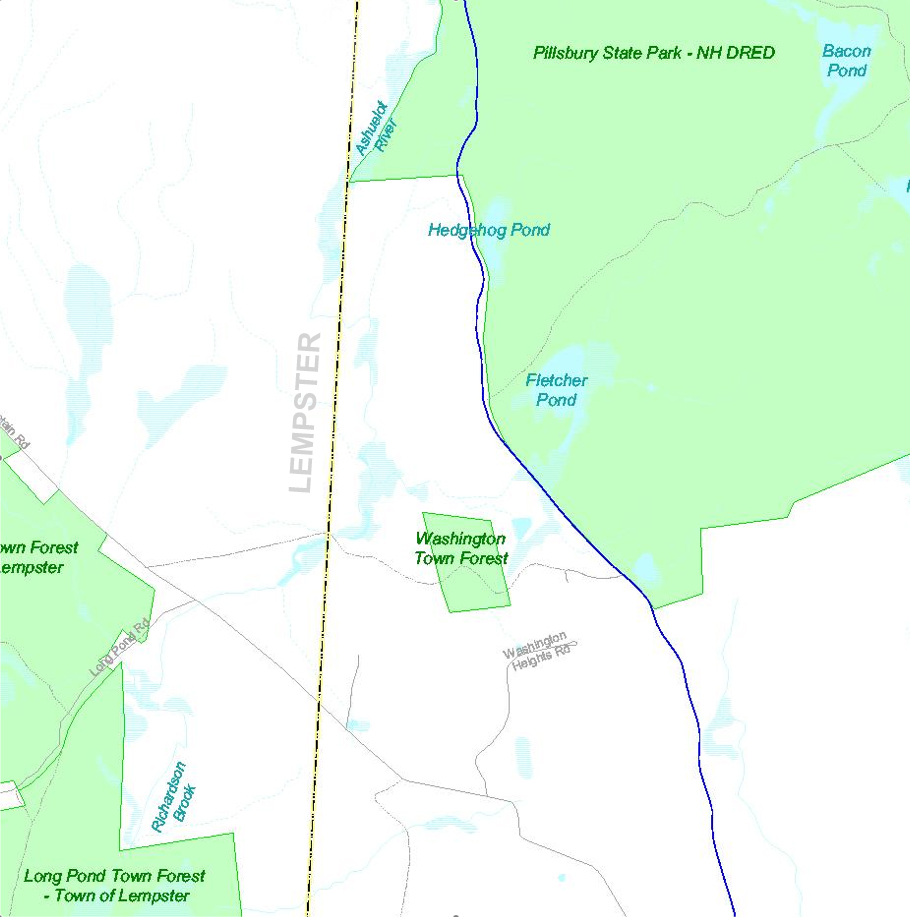|
At 45-acres, the New Road Lot is currently
the smallest of the forested properties the Town owns. Located
just south of Pillsbury State Park, however, this property
is an important conservation "stepping stone"
that may one day help to bridge two large forest blocks together.
Heading north, Pillsbury State Park is a large piece of a
very large forest complex that extends north all the way to
Lake Sunapee. Heading south, beginning in southern Washington,
is the equally large Andorra Forest complex that reaches down
to the Towns of Sullivan and Nelson. Each of these great forests
is more than 10,000 acres in size, representing the combined
determination of many private and public landowners to keep
southwestern New Hampshire wild and forested. It is now the
hope of many people throughout the region that someday these
two forests may become connected. If so, Washington Town forests
such as the New Road Lot will be important members of the
forested bridge that has yet to be built.

The New Road Lot does not have much diversity in terms of
wildlife habitat. The majority of the property is pole and
small sawtimber hardwoods (red maple, sugar maple, white ash
and yellow birch), with one softwood stand in the northwest
end (red spruce, balsam fir and red maple). Major wetland
features are lacking within the property, although a river
and swamp are located nearby. Future management activities
should include providing at least one one-half acre wildlife
opening, preferably away from New Road.
There are five management units on the New Road/Twin
Bridges property:
1) MU 1 consists of a well-stocked mixture of red spruce,
balsam fir and red maple, and is found in the northeast end
of the property. Most trees are pole-sized, with occasional
small-sawtimber stems scattered throughout. Much of this MU
includes bouldery terrain and wet soils that will make forest
management challenging, but not impossible.
2) MU 2 is a low quality and low value hardwood stand dominated
by red maple poles and scattered small sawtimber. The left-overs
from earlier high-grading ("take the best, leave the
rest"), this stand will need a lot of work before it
will become profitable. The western end of this MU has some
terrain problems that will have to be contented with.
3) MU 3 is a northern hardwood stand that is somewhat understocked
due to previous harvesting practices. This stand occupies
most of the southern half of the property, with a good representation
of valuable tree species such as white ash and sugar maple.
Unfortunately, red maple of only fair quality is by far the
most common species, but this can be corrected over time through
targeted thinnings. Trees range in size from poles to small
sawtimber, only pockets of which are currently well stocked.
4) MU 4 is made up of two small stands on opposite sides of
the property. This MU is very similar to MU3, except for the
additional presence of some scattered large sawtimber trees
(sugar maple, white ash, yellow birch and red maple). The
bulk of stems are still just poles, however, dominated by
sugar maple, red maple, and white ash.
5) MU 5 is distinguished by a large and impressive boulder
field, making this stand inoperable for timber management
purposes. As a lucky result, however, a small group of extremely
old and massive yellow birches have survived to the present
day. These trees are worthless as timber, having very poor
form and advanced decay in their boles. But they are priceless
for their size and age, and serve to remind us how the forests
of the past might have looked.
|

